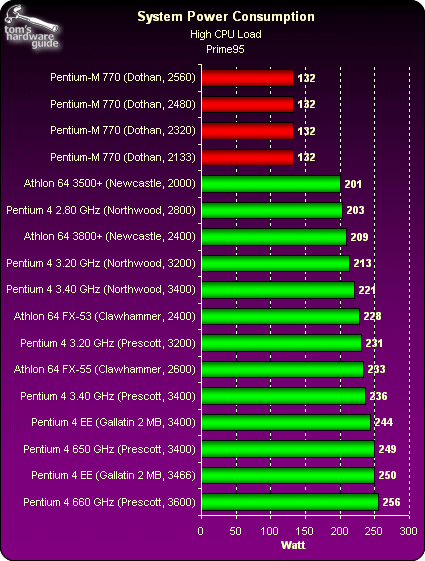Dothan Over Netburst: Is The Pentium 4 A Dead End?
Thermal Dissipation Loss And Power Consumption
Using this measuring device, we determined the power consumption of numerous system configurations. While it wouldn't meet scientific standards, it is certainly precise enough for our purposes.
For these measurements, we equipped our test system to mirror a typical configuration. This meant using components such as a GeForce 6800 GT graphics card, an optical drive, a floppy drive and two hard disks. Note that setting the hard drives up in a RAID array had only a minimal impact on our power measurements.
Some of our readers may be wondering why we didn't take a look at the individual processors' power draw instead. This wouldn't make much sense though, since ultimately we are interested in the power requirements of the complete system including its platform. What we wanted to find out was, how big a difference does the Pentium M really make?
Athlon 64 systems have one great advantage over the competition from Intel: the chipsets contain less logic, because the memory controller is integrated into the processor. As a result, most Athlon 64 chipsets are single-chip solutions, which helps to reduce overall power consumption. For reference, we have also included current AMD systems in our tables.
... Under Heavy CPU Load
That's quite the result! The Pentium M 770 system based on the P4C800-E only drew 132 W under heavy load. Any modern system, beginning with the Athlon 64 3500+, draws no less than 200 W under a similar load, and a fast LGA 775 Pentium 4 processor even needs 50 W more than that!
The results also show that the difference between the i865/875 platform and the i925 can't be all that big, either. The Pentium M needed a full 80 W less than the Pentium 4 Northwood 3.4 GHz, while still clearly outpacing it in almost every area at 2.5 GHz.
Get Tom's Hardware's best news and in-depth reviews, straight to your inbox.
Current page: Thermal Dissipation Loss And Power Consumption
Prev Page Synthetic, Continued Next Page ... Under Heavy CPU And Graphics Load
Patrick Schmid was the editor-in-chief for Tom's Hardware from 2005 to 2006. He wrote numerous articles on a wide range of hardware topics, including storage, CPUs, and system builds.

